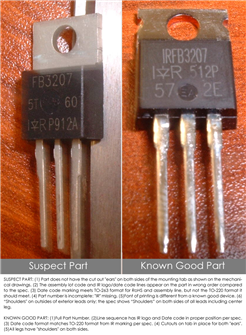How To Spot A Counterfeit Part- The Counterfeit Determination Dilemma
Anne-Liese Heinichen
ERAI, Inc.
While most government and private organizations can agree upon the definition of a counterfeit part, how, who and when to label a part as counterfeit remains a debatable issue. Within common industry standards, neither SAE AS9100, AS6081 nor AS5553 provide guidance on the matter. ARP6328 determines that, “the extent of inspection and testing depends on the level of risk the Organization and the Customer are willing to assume if a counterfeit part were used in the end-item equipment.”i
AS6171 does provide guidance in 3.7.1 Factors in Determination of Suspect/Counterfeit Parts, which includes the following language:
“The sum total of the observations from the complete Test Sequence is what establishes the overall conclusion. Counterfeit risk assessment requires an interpretation of the observation(s) and may require additional investigation within and outside the standard Test Sequence to determine if the indicator(s) are a quality concern in an authentic part or a counterfeit concern (see Appendix D).”ii
AS6171 goes on to provide some factors such as stating that one indicator may be enough for a determination if “conclusive enough” such as in the case of wrong or absent die; however, the next factor states that sometimes several factors may not be enough for a determination. Another factor recommends consultation with the original component manufacturer for a determination. It concludes by stating that, “if parts do not exhibit indicators that lead to a conclusion with a reasonable level of confidence that the parts are suspect/counterfeit, then the Test Laboratory shall make a final determination that the parts passed required testing and that there was no evidence of counterfeiting based on the testing performed.”iii Unfortunately, controversy surrounds AS6171 with many citing that the standard’s requirements do not allow for organizations to determine their own acceptable level of risk, are too strict and result in increased costs for organizations and their customers.
The Department of the Navy’s recently released “Counterfeit Materiel Process Guidebook, Guidelines for Mitigating the Risk of Counterfeit Materiel in the Supply Chain”, provides more detailed guidelines for determining whether or not materiel is suspect or counterfeit:
“The two best methods by which to determine materiel is suspect counterfeit are to:
1. Identify multiple suspect counterfeit indicators.
2. Obtain information from the OM to support that it is counterfeit.
Appendices F and H list many of these indicators, along with a minor, moderate, or major significance, defined as follows:
• Minor indicator - sign of quality or handling issues that might not be related to counterfeiting
• Moderate indicator - definite cause of suspicion for the part’s authenticity
• Major indicator - strong risk that the part has been modified and qualifies as counterfeit
Using the above as a basis for assigning significance, a threshold for reporting materiel to
PDREP and GIDEP as suspect counterfeit would occur if any one of the following conditions is
true:
• One major indicator and one moderate indicator
• Three or more moderate indicators
• Two or more moderate indicators and two or more minor indicatorsiv”
However, other than having direct confirmation from the Original Component Manufacturer, there is no widely accepted method for determining if a part is counterfeit. Many of the suspect parts reported to ERAI have undergone external and internal visual inspection test methods and were then classified as suspect counterfeit without further electrical testing being performed. Understandably, no organization would be expected to spend additional monies for extra testing on material that is already being rejected. Another problem involves the level of difficulty that organizations face when attempting to obtain assistance in authenticating product from original component manufacturers, especially for parts purchased from outside authorized or franchised distribution.
The need to detect, identify and classify material as authentic is of significant global importance in the electronics industry. Without clear industry or government direction, it is the responsibility of each organization in the supply chain to ensure that they have clearly defined how and when a counterfeit part determination is made and that this is specified within their documented counterfeit mitigation plan.
iSAE. Counterfeit EEE Part Detection. SAE ARP6328, SAE International, p. 19.
iiSAE. Factors in Determination of Suspect/Counterfeit Parts. SAE AS6171, SAE International, p. 46.
iiiSAE. Factors in Determination of Suspect/Counterfeit Parts. SAE AS6171, SAE International, p. 47.
ivOffice of the Assistant Secretary of the Navy (Research, Development & Acquisition) Acquisition and Business Management. Determination of Suspect Counterfeit. Counterfeit Materiel Process Guidebook, Guidelines for Mitigating the Risk of Counterfeit Materiel in the Supply Chain, Department of the Navy, p. 28.
SEE MORE BLOG ENTRIES
|

Suspect Part vs. Known Good Part
|